 Sunday/Weekend
Sunday/Weekend

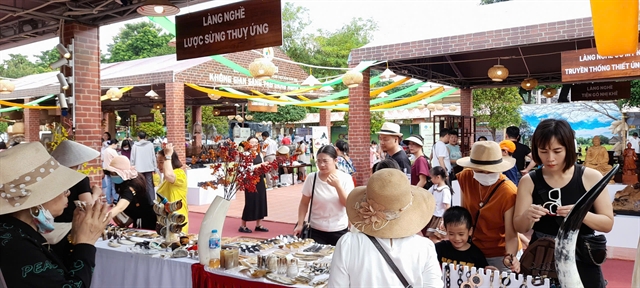 |
| Products of Thụy Ứng craft village attract a large number of visitors at a fair in Hà Nội. — VNS Photo Thanh Nga |
By Thanh Nga
Thụy Ứng Village on the outskirts of Hà Nội holds a distinguished reputation as the only village in northern Việt Nam specialising in crafting combs from cattle horns.
With over 400 years of history, the village, lying in Hòa Bình Commune, Thường Tín District, has not only withstood the test of time but has also become an attractive destination for tourists interested in exploring Hà Nội's rich handicraft heritage.
Travellers starting from Hà Nội can take National Highway 1A south to Thường Tín railway station, then turn onto Provincial Road 427 westward and drive about 3km to reach Thụy Ứng Village.
The village exudes a tranquil charm, deeply rooted in its cultural traditions. Today, local authorities are investing in its development as a traditional craft village tourism destination, blending elements of spiritual and community-based tourism to enrich visitors’ experiences.
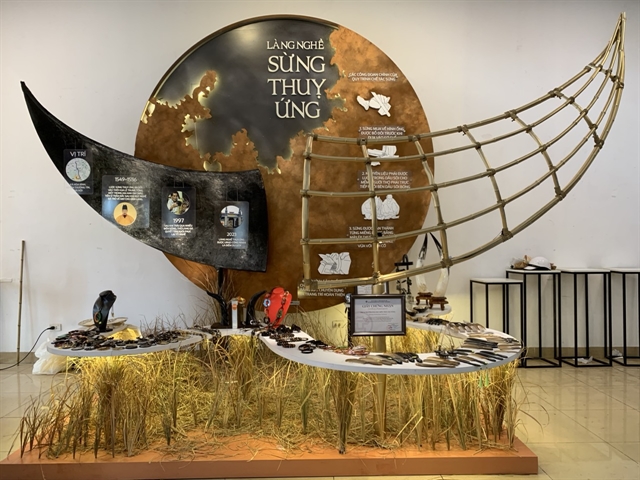 |
| Thụy Ứng horn comb craft village is located in Hòa Bình Commune, Thường Tín District, Hà Nội. — Photo Facebook of Thụy Ứng Horn Comb |
“Our village is fortunate to have inherited the rare ancient craft of making combs from buffalo and cow horns. Currently, there is no other village in the north that specialises in this craft,” artisan Nguyễn Văn Sử says with pride.
The artisans of Thụy Ứng have mastered the transformation of tough cattle horns into delicate, aesthetically pleasing combs adorned with intricate motifs. Each comb, they believe, carries the artist’s passion and dedication to beauty, earning Thụy Ứng the reputation for “breathing life into combs”.
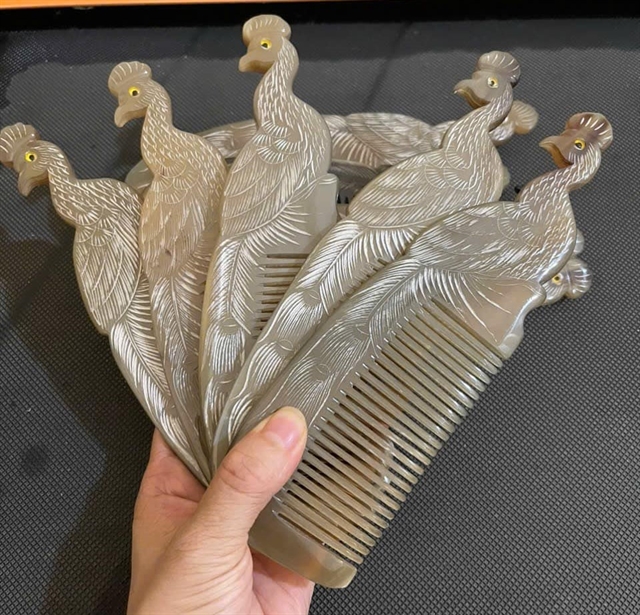 |
| Thụy Ứng Village is renowned as the only craft village in northern Việt Nam specialising in combs handmade from buffalo and cow horns. — Photo Facebook of Thụy Ứng Horn Comb |
The crafting process
The primary material—buffalo horns and hooves—are sourced from the northern mountainous regions. When local supplies are insufficient, Thụy Ứng comb makers turn to imports from Laos, Thailand, Cambodia, and even Africa.
Horn combs, prized for their quality, are valued more than those made from hooves. The colour of buffalo horns varies by regions of origin, with Vietnamese buffalo horns typically being black, while African variants can be ivory.
“The best horns come from older, robust buffaloes. They are thicker, glossier, and exhibit beautiful veins. White buffalo horn, in particular, is prized for its quality and rarity,” local craftsman Nguyễn Thành Trung says.
Crafting horn combs is a meticulous and labour-intensive process involving several steps.
The process begins by cutting the horn to a thickness of about 4-5 millimetres. Traditionally, craftsmen would soften the horn by covering it with hot ash. But now it is boiled in oil at approximately 200 degrees Celsius for four to five minutes, then rinsed with cold water.
Once softened, the horn is flattened using a hydraulic press. Younger buffalo horns are easier to carve, while older ones are more brittle.
Craftsmen carefully mark the comb’s shape on the flattened horn, ensuring that carving against the grain enhances durability.
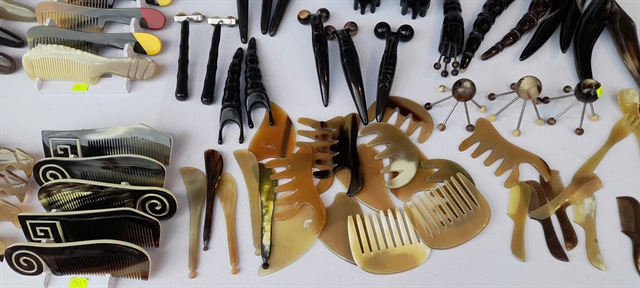 |
| Thụy Ứng artisans have diversified their products to include various household items and decorative items for restaurants and hotels.— VNS Photo Thanh Nga |
Evolving craftsmanship
With traditional methods a worker could produce 30-40 combs per day, while using machinery he could double his daily output to 70-100 pieces.
The price for a plain comb ranges from VNĐ20,000 to VNĐ40,000, and skilled craftsmen can earn between VNĐ150,000 and VNĐ500,000 daily, depending on market demand.
Beyond combs, Thụy Ứng craftspeople have diversified their craft to include various household items such as spoons, teapots, cups, bowls, plates, wine jars, toothpick boxes, ashtrays, and chopsticks. Many also create intricate art pieces, such as figurines of shrimp, dragon, and phoenix, along with decorative items for restaurants and hotels.
“Through the years, we’ve not only maintained our craft but also prospered from it. We import over three containers of raw materials each month, mainly buffalo horns from India and Africa, providing stable jobs for 40 workers,” Nguyễn Xuân Huy, whose family has practised the craft for generations, says.
Hoàng Văn Thắng, chairman of the Hòa Bình Commune People's Committee [Commune Chief], highlights the resilience of the village’s craft industry: “The craft of making horn combs in Thụy Ứng has thrived for over 400 years. Despite market fluctuations and competition, the village remains dedicated to preserving and developing this unique craft.”
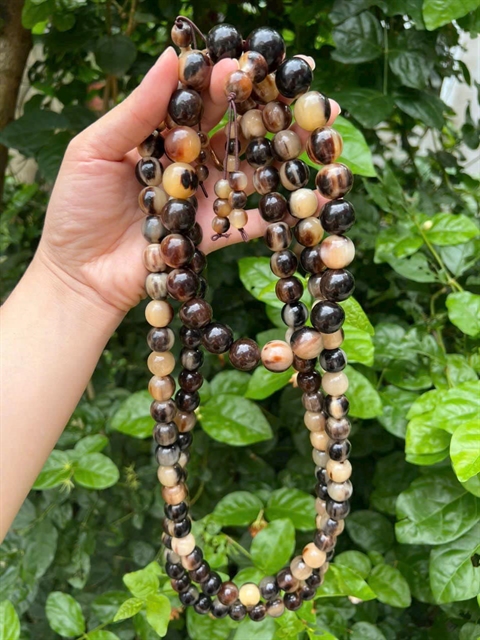 |
| Horn bead necklaces, handmade products of Thụy Ứng craft village. — Photo Facebook of Thụy Ứng Horn Comb |
Thắng says that Hà Nội’s recognition of Thụy Ứng as a tourist destination offers significant opportunities for Thường Tín District to promote its tourism potential, preserve and showcase cultural values, and develop distinctive tourism products for the city.
To meet the criteria of a tourist destination, the local government has re-zoned the village, including two additional areas spanning 61.2ha focused on craft households, shops, and displays of Thụy Ứng products.
Nguyễn Mạnh Thản, chairman of the Hà Nội Tourism Association, remarks on the growing diversity of horn products, including bracelets and other jewellery, massage tools, which have made Thụy Ứng a popular destination for tourists seeking quality handicrafts.
Today, Thụy Ứng products are sold not only throughout Việt Nam but also exported to China, Thailand, the UK, and the US.
Thụy Ứng craft village stands as a testament to Việt Nam’s rich handicraft heritage, blending tradition with innovation to captivate visitors at home and from abroad.
The village’s unique creations highlight its historical significance and cultural value, paving the way for a vibrant future in tourism and craft preservation. VNS
 |
| A craftsman gives a brief demonstration of horn comb making to tourists who visit Thụy Ứng Village. — Photo Facebook of Thụy Ứng Horn Comb |




